Amrit Singh Bedi
Test-Time Scaling in Diffusion LLMs via Hidden Semi-Autoregressive Experts
Oct 06, 2025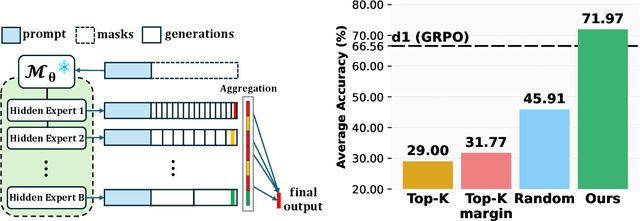
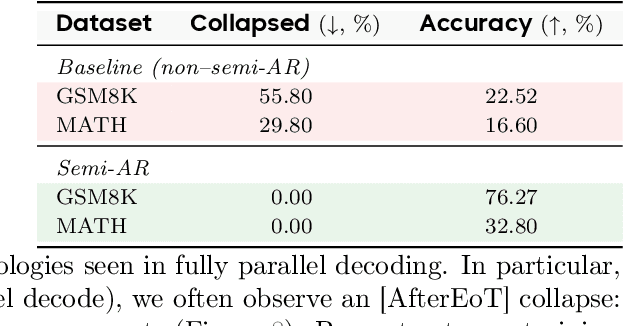
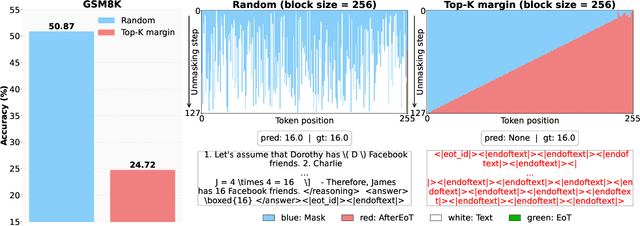
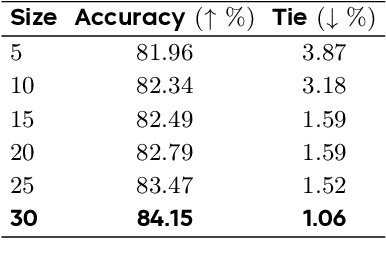
Abstract:Diffusion-based large language models (dLLMs) are trained flexibly to model extreme dependence in the data distribution; however, how to best utilize this information at inference time remains an open problem. In this work, we uncover an interesting property of these models: dLLMs trained on textual data implicitly learn a mixture of semi-autoregressive experts, where different generation orders reveal different specialized behaviors. We show that committing to any single, fixed inference time schedule, a common practice, collapses performance by failing to leverage this latent ensemble. To address this, we introduce HEX (Hidden semiautoregressive EXperts for test-time scaling), a training-free inference method that ensembles across heterogeneous block schedules. By doing a majority vote over diverse block-sized generation paths, HEX robustly avoids failure modes associated with any single fixed schedule. On reasoning benchmarks such as GSM8K, it boosts accuracy by up to 3.56X (from 24.72% to 88.10%), outperforming top-K margin inference and specialized fine-tuned methods like GRPO, without additional training. HEX even yields significant gains on MATH benchmark from 16.40% to 40.00%, scientific reasoning on ARC-C from 54.18% to 87.80%, and TruthfulQA from 28.36% to 57.46%. Our results establish a new paradigm for test-time scaling in diffusion-based LLMs (dLLMs), revealing that the sequence in which masking is performed plays a critical role in determining performance during inference.
MIRA: Towards Mitigating Reward Hacking in Inference-Time Alignment of T2I Diffusion Models
Oct 02, 2025Abstract:Diffusion models excel at generating images conditioned on text prompts, but the resulting images often do not satisfy user-specific criteria measured by scalar rewards such as Aesthetic Scores. This alignment typically requires fine-tuning, which is computationally demanding. Recently, inference-time alignment via noise optimization has emerged as an efficient alternative, modifying initial input noise to steer the diffusion denoising process towards generating high-reward images. However, this approach suffers from reward hacking, where the model produces images that score highly, yet deviate significantly from the original prompt. We show that noise-space regularization is insufficient and that preventing reward hacking requires an explicit image-space constraint. To this end, we propose MIRA (MItigating Reward hAcking), a training-free, inference-time alignment method. MIRA introduces an image-space, score-based KL surrogate that regularizes the sampling trajectory with a frozen backbone, constraining the output distribution so reward can increase without off-distribution drift (reward hacking). We derive a tractable approximation to KL using diffusion scores. Across SDv1.5 and SDXL, multiple rewards (Aesthetic, HPSv2, PickScore), and public datasets (e.g., Animal-Animal, HPDv2), MIRA achieves >60\% win rate vs. strong baselines while preserving prompt adherence; mechanism plots show reward gains with near-zero drift, whereas DNO drifts as compute increases. We further introduce MIRA-DPO, mapping preference optimization to inference time with a frozen backbone, extending MIRA to non-differentiable rewards without fine-tuning.
Leveraging Pre-Trained Visual Models for AI-Generated Video Detection
Jul 17, 2025



Abstract:Recent advances in Generative AI (GenAI) have led to significant improvements in the quality of generated visual content. As AI-generated visual content becomes increasingly indistinguishable from real content, the challenge of detecting the generated content becomes critical in combating misinformation, ensuring privacy, and preventing security threats. Although there has been substantial progress in detecting AI-generated images, current methods for video detection are largely focused on deepfakes, which primarily involve human faces. However, the field of video generation has advanced beyond DeepFakes, creating an urgent need for methods capable of detecting AI-generated videos with generic content. To address this gap, we propose a novel approach that leverages pre-trained visual models to distinguish between real and generated videos. The features extracted from these pre-trained models, which have been trained on extensive real visual content, contain inherent signals that can help distinguish real from generated videos. Using these extracted features, we achieve high detection performance without requiring additional model training, and we further improve performance by training a simple linear classification layer on top of the extracted features. We validated our method on a dataset we compiled (VID-AID), which includes around 10,000 AI-generated videos produced by 9 different text-to-video models, along with 4,000 real videos, totaling over 7 hours of video content. Our evaluation shows that our approach achieves high detection accuracy, above 90% on average, underscoring its effectiveness. Upon acceptance, we plan to publicly release the code, the pre-trained models, and our dataset to support ongoing research in this critical area.
Does Thinking More always Help? Understanding Test-Time Scaling in Reasoning Models
Jun 04, 2025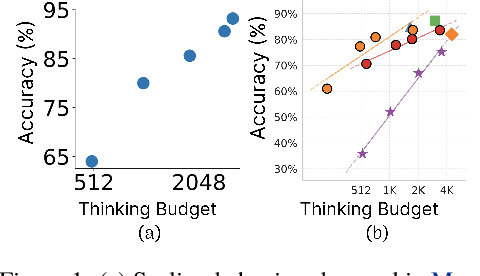
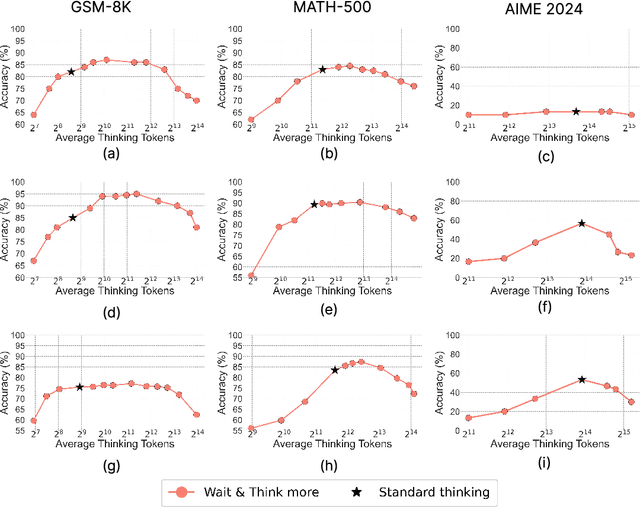
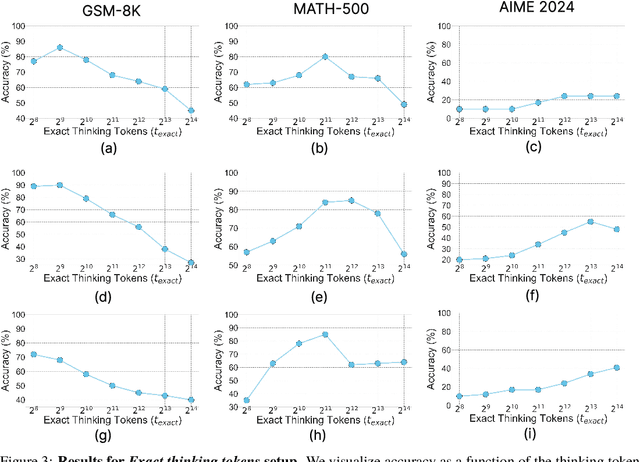
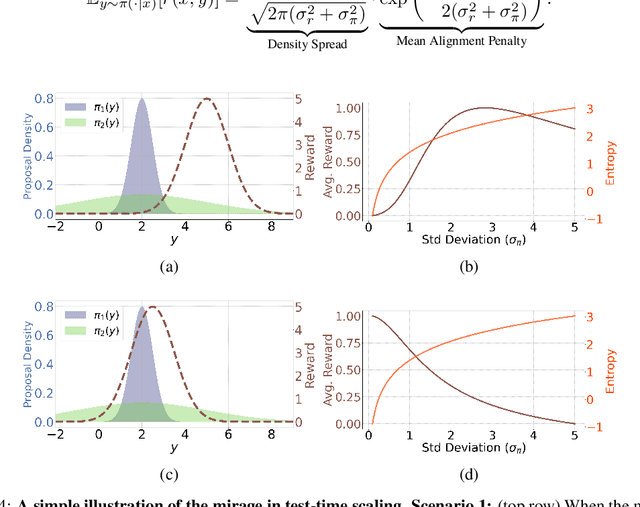
Abstract:Recent trends in test-time scaling for reasoning models (e.g., OpenAI o1, DeepSeek R1) have led to a popular belief that extending thinking traces using prompts like "Wait" or "Let me rethink" can improve performance. This raises a natural question: Does thinking more at test-time truly lead to better reasoning? To answer this question, we perform a detailed empirical study across models and benchmarks, which reveals a consistent pattern of initial performance improvements from additional thinking followed by a decline, due to "overthinking". To understand this non-monotonic trend, we consider a simple probabilistic model, which reveals that additional thinking increases output variance-creating an illusion of improved reasoning while ultimately undermining precision. Thus, observed gains from "more thinking" are not true indicators of improved reasoning, but artifacts stemming from the connection between model uncertainty and evaluation metric. This suggests that test-time scaling through extended thinking is not an effective way to utilize the inference thinking budget. Recognizing these limitations, we introduce an alternative test-time scaling approach, parallel thinking, inspired by Best-of-N sampling. Our method generates multiple independent reasoning paths within the same inference budget and selects the most consistent response via majority vote, achieving up to 20% higher accuracy compared to extended thinking. This provides a simple yet effective mechanism for test-time scaling of reasoning models.
Bounded Rationality for LLMs: Satisficing Alignment at Inference-Time
May 29, 2025Abstract:Aligning large language models with humans is challenging due to the inherently multifaceted nature of preference feedback. While existing approaches typically frame this as a multi-objective optimization problem, they often overlook how humans actually make decisions. Research on bounded rationality suggests that human decision making follows satisficing strategies-optimizing primary objectives while ensuring others meet acceptable thresholds. To bridge this gap and operationalize the notion of satisficing alignment, we propose SITAlign: an inference time framework that addresses the multifaceted nature of alignment by maximizing a primary objective while satisfying threshold-based constraints on secondary criteria. We provide theoretical insights by deriving sub-optimality bounds of our satisficing based inference alignment approach. We empirically validate SITAlign's performance through extensive experimentation on multiple benchmarks. For instance, on the PKU-SafeRLHF dataset with the primary objective of maximizing helpfulness while ensuring a threshold on harmlessness, SITAlign outperforms the state-of-the-art multi objective decoding strategy by a margin of 22.3% in terms of GPT-4 win-tie rate for helpfulness reward while adhering to the threshold on harmlessness.
Sample Complexity of Diffusion Model Training Without Empirical Risk Minimizer Access
May 23, 2025Abstract:Diffusion models have demonstrated state-of-the-art performance across vision, language, and scientific domains. Despite their empirical success, prior theoretical analyses of the sample complexity suffer from poor scaling with input data dimension or rely on unrealistic assumptions such as access to exact empirical risk minimizers. In this work, we provide a principled analysis of score estimation, establishing a sample complexity bound of $\widetilde{\mathcal{O}}(\epsilon^{-6})$. Our approach leverages a structured decomposition of the score estimation error into statistical, approximation, and optimization errors, enabling us to eliminate the exponential dependence on neural network parameters that arises in prior analyses. It is the first such result which achieves sample complexity bounds without assuming access to the empirical risk minimizer of score function estimation loss.
Review, Refine, Repeat: Understanding Iterative Decoding of AI Agents with Dynamic Evaluation and Selection
Apr 02, 2025Abstract:While AI agents have shown remarkable performance at various tasks, they still struggle with complex multi-modal applications, structured generation and strategic planning. Improvements via standard fine-tuning is often impractical, as solving agentic tasks usually relies on black box API access without control over model parameters. Inference-time methods such as Best-of-N (BON) sampling offer a simple yet effective alternative to improve performance. However, BON lacks iterative feedback integration mechanism. Hence, we propose Iterative Agent Decoding (IAD) which combines iterative refinement with dynamic candidate evaluation and selection guided by a verifier. IAD differs in how feedback is designed and integrated, specifically optimized to extract maximal signal from reward scores. We conduct a detailed comparison of baselines across key metrics on Sketch2Code, Text2SQL, and Webshop where IAD consistently outperforms baselines, achieving 3--6% absolute gains on Sketch2Code and Text2SQL (with and without LLM judges) and 8--10% gains on Webshop across multiple metrics. To better understand the source of IAD's gains, we perform controlled experiments to disentangle the effect of adaptive feedback from stochastic sampling, and find that IAD's improvements are primarily driven by verifier-guided refinement, not merely sampling diversity. We also show that both IAD and BON exhibit inference-time scaling with increased compute when guided by an optimal verifier. Our analysis highlights the critical role of verifier quality in effective inference-time optimization and examines the impact of noisy and sparse rewards on scaling behavior. Together, these findings offer key insights into the trade-offs and principles of effective inference-time optimization.
Learning Multi-Robot Coordination through Locality-Based Factorized Multi-Agent Actor-Critic Algorithm
Mar 24, 2025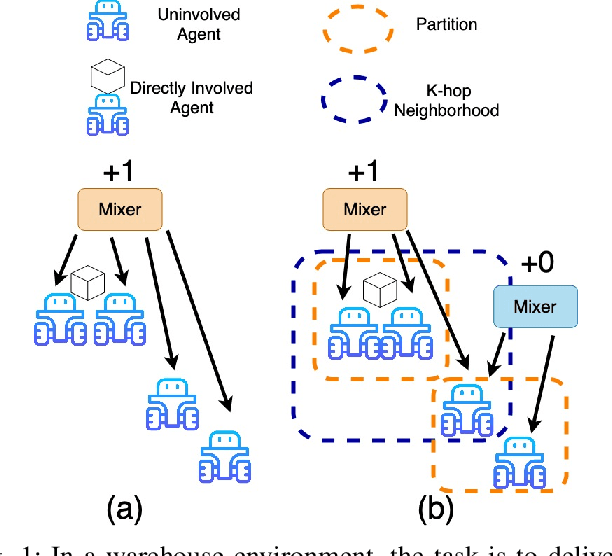
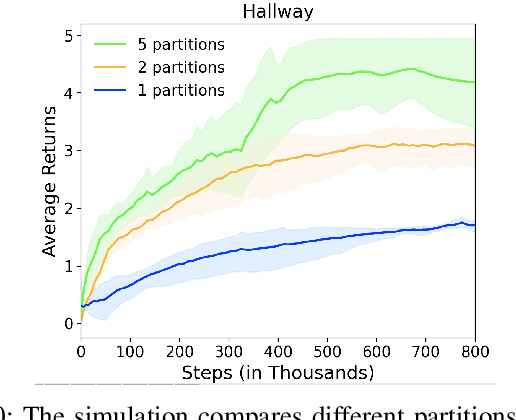
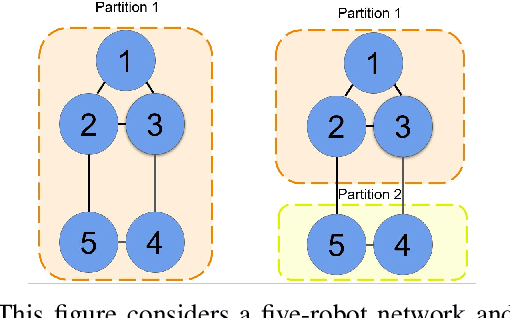
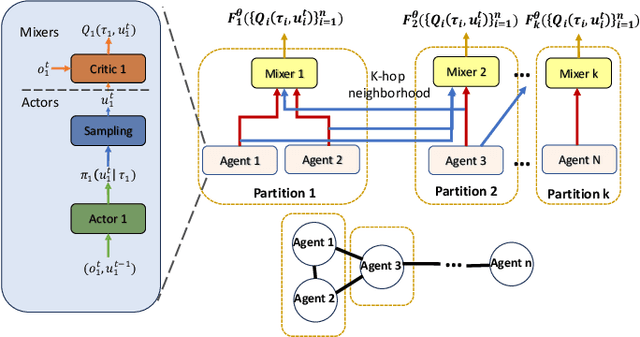
Abstract:In this work, we present a novel cooperative multi-agent reinforcement learning method called \textbf{Loc}ality based \textbf{Fac}torized \textbf{M}ulti-Agent \textbf{A}ctor-\textbf{C}ritic (Loc-FACMAC). Existing state-of-the-art algorithms, such as FACMAC, rely on global reward information, which may not accurately reflect the quality of individual robots' actions in decentralized systems. We integrate the concept of locality into critic learning, where strongly related robots form partitions during training. Robots within the same partition have a greater impact on each other, leading to more precise policy evaluation. Additionally, we construct a dependency graph to capture the relationships between robots, facilitating the partitioning process. This approach mitigates the curse of dimensionality and prevents robots from using irrelevant information. Our method improves existing algorithms by focusing on local rewards and leveraging partition-based learning to enhance training efficiency and performance. We evaluate the performance of Loc-FACMAC in three environments: Hallway, Multi-cartpole, and Bounded-Cooperative-Navigation. We explore the impact of partition sizes on the performance and compare the result with baseline MARL algorithms such as LOMAQ, FACMAC, and QMIX. The experiments reveal that, if the locality structure is defined properly, Loc-FACMAC outperforms these baseline algorithms up to 108\%, indicating that exploiting the locality structure in the actor-critic framework improves the MARL performance.
BalancedDPO: Adaptive Multi-Metric Alignment
Mar 16, 2025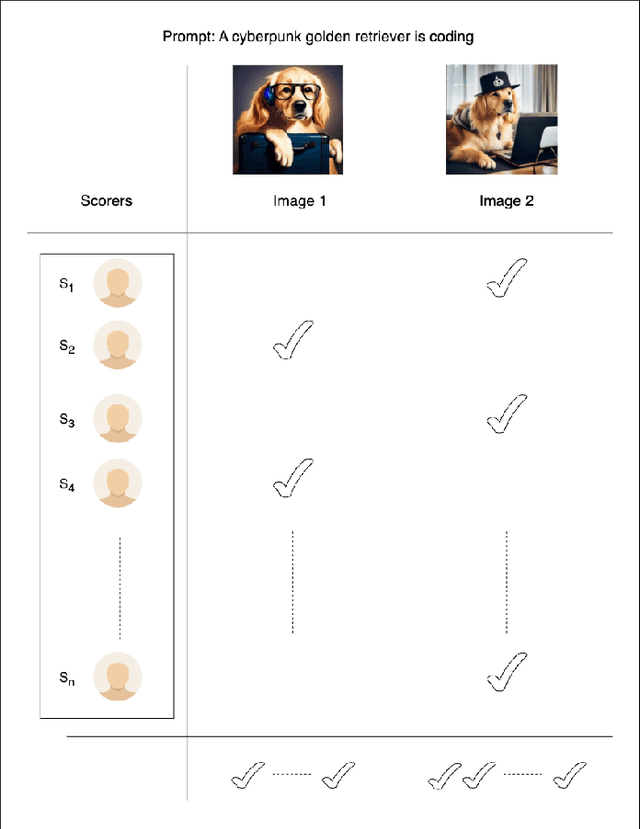



Abstract:Text-to-image (T2I) diffusion models have made remarkable advancements, yet aligning them with diverse preferences remains a persistent challenge. Current methods often optimize single metrics or depend on narrowly curated datasets, leading to overfitting and limited generalization across key visual quality metrics. We present BalancedDPO, a novel extension of Direct Preference Optimization (DPO) that addresses these limitations by simultaneously aligning T2I diffusion models with multiple metrics, including human preference, CLIP score, and aesthetic quality. Our key novelty lies in aggregating consensus labels from diverse metrics in the preference distribution space as compared to existing reward mixing approaches, enabling robust and scalable multi-metric alignment while maintaining the simplicity of the standard DPO pipeline that we refer to as BalancedDPO. Our evaluations on the Pick-a-Pic, PartiPrompt and HPD datasets show that BalancedDPO achieves state-of-the-art results, outperforming existing approaches across all major metrics. BalancedDPO improves the average win rates by 15%, 7.1%, and 10.3% on Pick-a-pic, PartiPrompt and HPD, respectively, from the DiffusionDPO.
Align-Pro: A Principled Approach to Prompt Optimization for LLM Alignment
Jan 07, 2025



Abstract:The alignment of large language models (LLMs) with human values is critical as these models become increasingly integrated into various societal and decision-making processes. Traditional methods, such as reinforcement learning from human feedback (RLHF), achieve alignment by fine-tuning model parameters, but these approaches are often computationally expensive and impractical when models are frozen or inaccessible for parameter modification. In contrast, prompt optimization is a viable alternative to RLHF for LLM alignment. While the existing literature has shown empirical promise of prompt optimization, its theoretical underpinning remains under-explored. We address this gap by formulating prompt optimization as an optimization problem and try to provide theoretical insights into the optimality of such a framework. To analyze the performance of the prompt optimization, we study theoretical suboptimality bounds and provide insights in terms of how prompt optimization depends upon the given prompter and target model. We also provide empirical validation through experiments on various datasets, demonstrating that prompt optimization can effectively align LLMs, even when parameter fine-tuning is not feasible.
 Add to Chrome
Add to Chrome Add to Firefox
Add to Firefox Add to Edge
Add to Edge